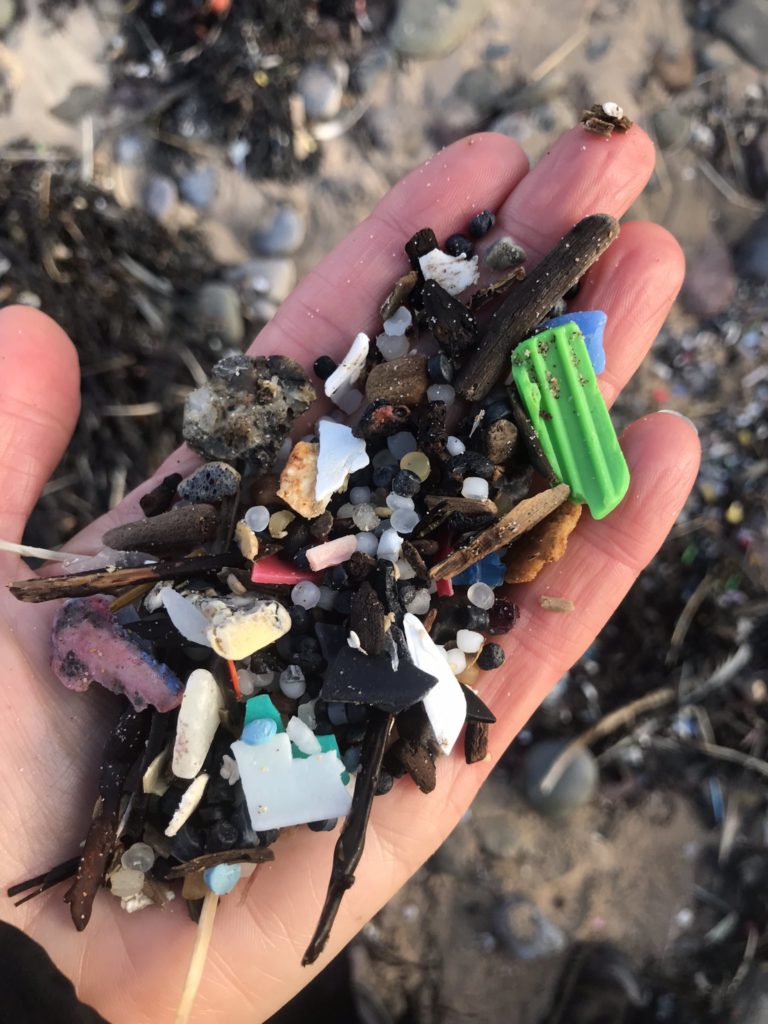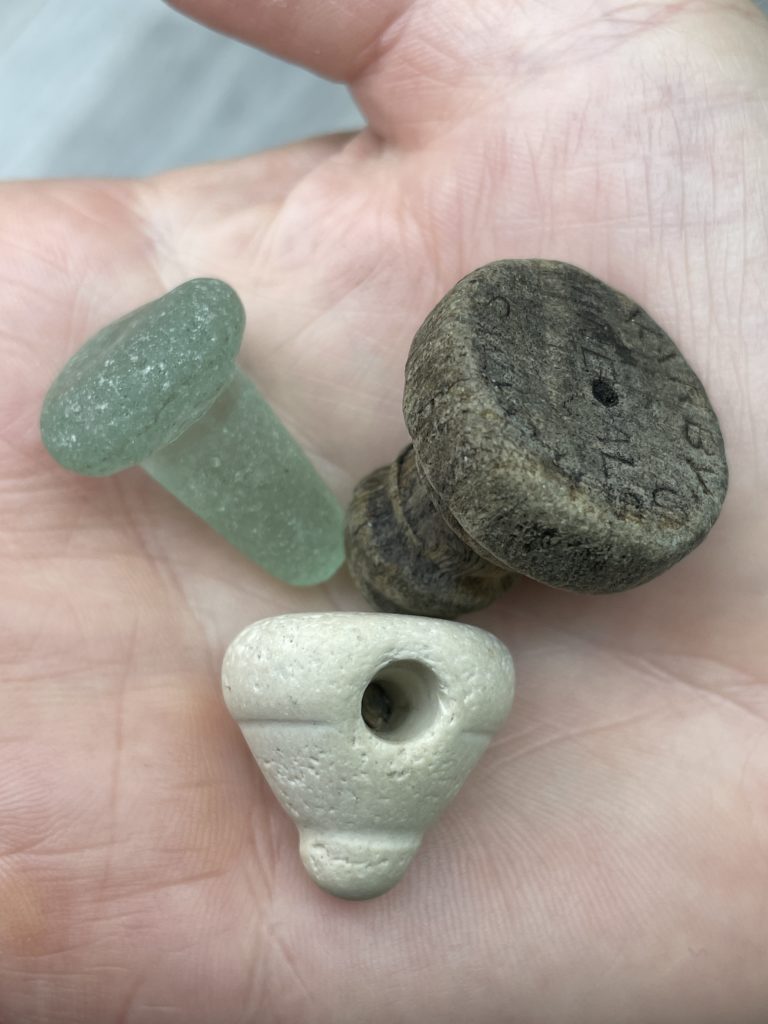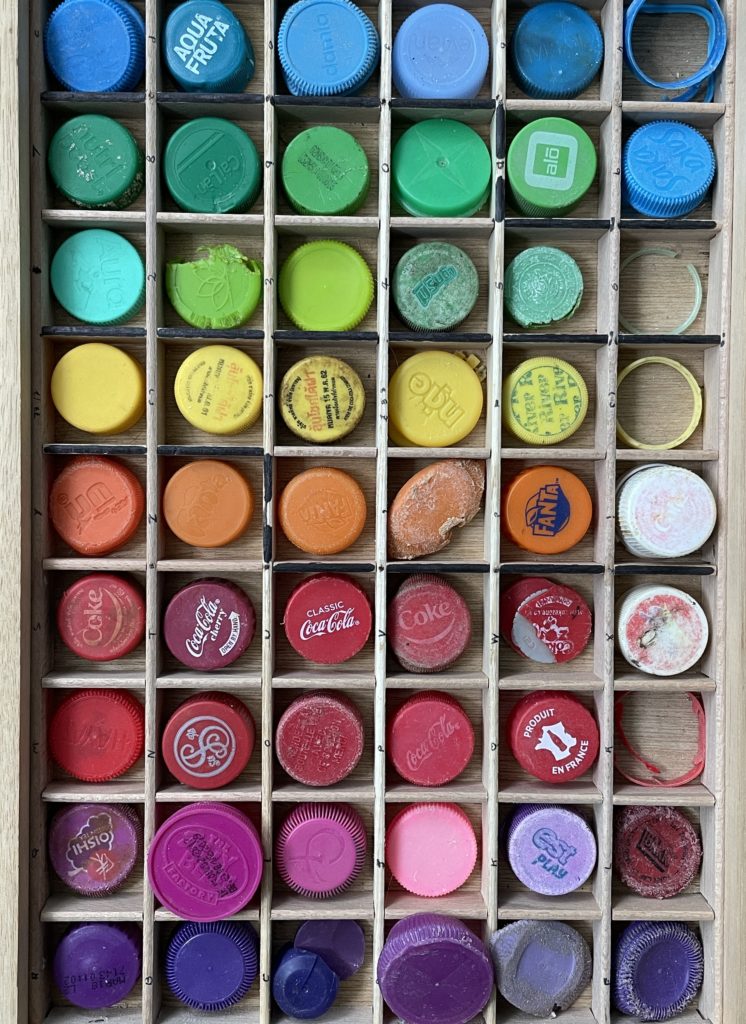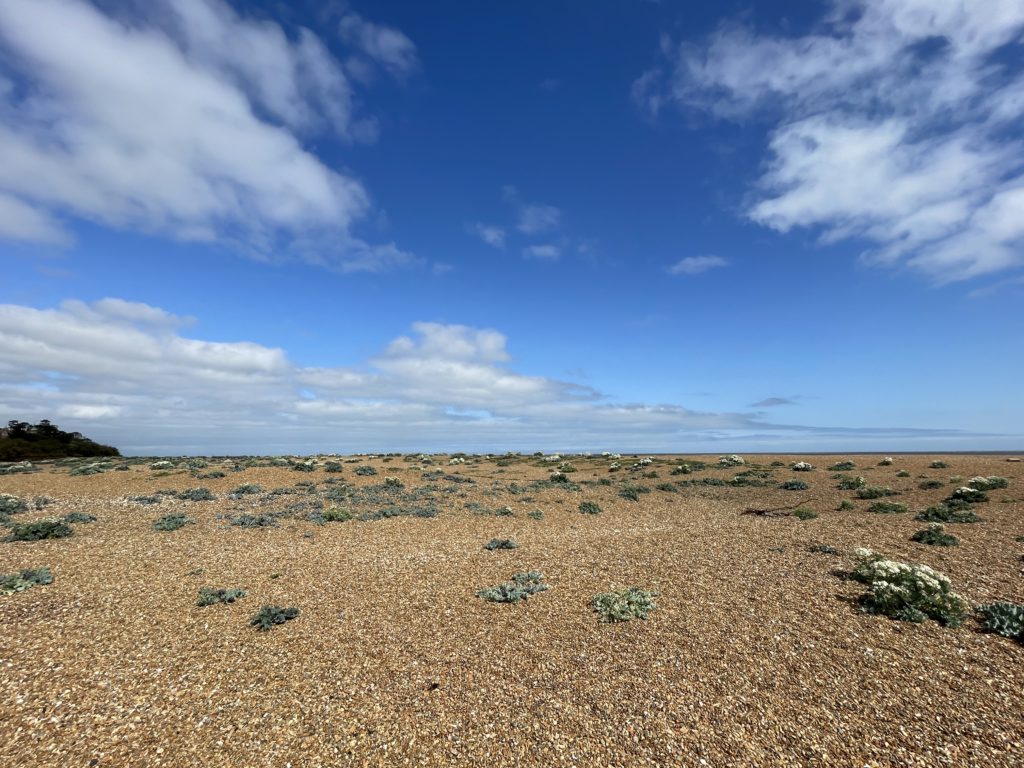by Kate Osborne
I remember the first time I ever saw someone collecting rubbish from the beach. It was a beautiful white sand cove in Corsica. What struck me as odd wasn’t the fact that he was stark naked (it really was a deserted beach!) but that he was carrying a torn white plastic feed sack and he was using it as a sling for all sorts of other litter. I’m ashamed to say I laughed – whether inwardly or outwardly I’m not sure – but I’m still friends with him and the rest of his family, so it can’t have been that obvious.
I am trying hard now some thirty years on to understand my reaction. Perhaps it was embarrassment that he had to do that. You went to the beach to lie in the sun, read a book, hunt for shells, go for a swim, but not to go on a litter-pick. It never even occurred to me to ask why is there litter on a beach?
Now three decades on I am pretty good at identifying beach litter and knowing where it comes from. I run Beach Bonkers, taking people on guided beachcombing walks and giving beachcombing talks, and I volunteer my time as a quarterly beach clean organiser. At both types of event, participants express surprise at how clean the beach is.
That is until they really start to look. When beachcombing for the tiny treasures like sharks’ teeth in the shingle you find the tiny pieces of trash too.
A handful of broken plastic from a Welsh beach including the lentil-shaped nurdles (pre-production plastic pellets) (c) Jules O’Shea
I can still clearly picture myself standing in the kitchen with my partner after the last episode of Blue Planet. Social media was alight with horror at the images portrayed of the plastic in our oceans – and its creatures. It was old news to those of us who beachcomb and beach clean but I wondered whether I should make a move away from beachcombing to beach cleaning?
My focus had always been on the natural world and in particular our Suffolk shingle. More properly known as Vegetated Shingle Habitat, it is an internationally rare, and surprisingly fragile, home for many creatures. I asked my partner if now was the time to focus on beach cleaning. He wisely said no, just keep doing what you’re doing and I’m so glad I took his advice.
Some seven years on I’ve discovered that, through beachcombing, once people see quite how many treasures can be found that show the wealth of wildlife living on, in and around our coasts, looking after them (including by beach cleaning) becomes second nature.
It’s hard not to be dispirited. Some think it’s not even worth bothering because the scale of the problem is so huge. And an online search of the world’s great garbage patches will certainly reinforce that feeling.
However, I am a huge fan of the Quaker saying “it is better to light a candle than curse the darkness”. Similarly I once heard how “long does it take to clean all the streets of Paris” The wonderfully lateral and uplifting answer is “ten minutes – if everyone does the bit in front of their own house.” That gives me strength.
So what can we do about it?
Martin Dorey who started the 2 minute beach clean movement in Cornwall reckoned that if everyone who went to the beach spent an extra two minutes picking up litter it would and could make a difference. Evidence of the many who take part is regularly posted on social media. Every single bit of plastic you collect from the beach is no longer threatening to choke or entangle a sea creature. And it won’t have the chance to break down into thousands of tiny, toxic pieces of micro plastic that will be ingested by those sea creatures. And even if you’re landlocked, every piece of litter you collect from the streets won’t have the chance to be broken up and go down a street drain into our waterways and eventually the sea.
A lot of online social media pictures of rubbish have things arranged in the order of the colours of the rainbow. I understand why. That colour arc is immensely pleasing to the eye but … it runs the danger somehow of trivialising the issue, it’s still a load of unnecessary plastic tat made to look pretty. I recall vividly an image of a rock pool full of artfully arranged bottle tops. It got a lot of likes, but did people who weren’t beachcombers and cleaners get the message about how many bottle tops we find regularly on beaches? As you can see from the image below I succumbed to the temptation.
Things washing up onto beaches are not new but there’s a big difference between the planks and oranges from the wrecks of old versus thousands of bright pink plastic Vanish bottles washing up after a cargo spill. I listened aghast to a radio broadcaster implying how fun it all was that the beaches were turning pink after the Vanish spill made the news!
Beachcombed glass, ceramic and wooden bottle stoppers. The latter says “Kirby’s Minerals – Ipswich.” (c) Kate Osborne
More recently discarded beachcombed plastic bottle tops. (c) Kate Osborne
Because over 80% of our beach rubbish is plastic. You name it, it’s been found on a beach. From the obvious: deflated footballs, beach toys and picnic remains, to the slightly less obvious hair bands and snorkel rings that have been lost whilst swimming to the “disposable” contact lenses flushed down toilets and the bizarre: bullet proof vests and tailors’ dummies. Building waste and tiles from construction near the coast. Things we fire up into the sky that come back down: balloons, their strings and plastic tags, the plastic innards of fireworks, plastic confetti, and plastic shotgun cartridges and wadding. Plastic flowers used for decoration. Plastic straws, plastic cutlery and plastic cups. Plastic cigarette stubs and filters, plastic cigarette filters’ plastic wrappings, “disposable” plastic vapes, and “disposable” plastic lighters. Seems we like throwing things away. But there is no such thing as “away” – it all ends up somewhere.
Ask anyone where they think all this plastic litter comes from and inevitably the answers are “shipping” and “fishing.” Yet 80% of marine rubbish can be traced back to a land-based source.
This figure comes from the extensive data collected from the Marine Conservation Society (MCS) Beachwatch surveys where organisers like myself adopt a 100 metre stretch of beach. We clean it at least quarterly with other volunteers and record everything we find. This has led to lobbying for and changes to legislation on the availability of single use plastic items like cotton bud sticks, coffee stirrers and straws. We can only hope the government finally pulls its finger out and bans plastic wet wipes!
The MCS website at mcsuk.org/what-you-can-do/join-a-beach-clean lists beachcombs you can join in your area and has details of how to become a beach clean organiser and adopt your very own 100 metre stretch of beach.
It’s lovely to litter-pick with others who are like-minded. I can sometimes feel a bit odd collecting rubbish by myself. I always want to cheer when I see someone else doing it though, whether by the sea or not. A fellow soldier! Someone once said to me “you’re a real hero for doing that”. My fab reply didn’t of course come to me until much later: “but you can be a hero too!”
Personally I think there are several issues at play. The first is the non-stop advertising we are bombarded with on television, in cinemas, on our phones, on the side of buses. It’s an insidious, drip, drip, drip of repetition. All exhorting us to make our house cleaner, tidier, brighter and our lives happier and more fulfilling if only we buy this or that disposable product. There’s no point in selling someone a mop once when you can sell them a mop head that requires them to buy endless packets of “disposable” mop wipes.
The second is that there are so many things that are made of plastic that are not immediately obvious as plastic: wet wipes, fleecy pyjamas, fluffy socks. But the “fluff” and the “fleece” is plastic.
And the third is that although we are all exhorted to recycle our plastic I wish we could just be a bit more clever about how we use it. Sometimes people will turn up for a beachcomb clutching a brand new zip lock food bag. I always ask them to take it back home and use it for their sandwiches until it’s almost worn out then bring it back to the beach to collect your treasures. But as I ask everyone to leave almost everything they find behind on a beachcomb anyway, it’s best used for rubbish. If we can all consume a little less plastic then there’s less of it about to end up on the beach.
Bawdsey beach (c) Kate Osborne
I read somewhere that collecting rubbish from a beach is the most effective smallscale way to clean our oceans. The tide is relentless. It comes in twice a day, every day. I am landlocked, I don’t live near the sea but if I did I would be out there every day scouring the beach for both treasures and trash – leaving the treasures behind and getting rid of the trash every day. The thing is once you slow down and really start looking you can’t not see it, whether it’s trash or treasure. Some we need to leave behind, the rest we can put in a bin.
By the end of that day on the beach in Corsica I’d shed all my clothes too – and was collecting litter with the other naked people!
Join me in Felixstowe on Sunday 25th June for a beach clean and survey from 10:00am – 12:00 and for a beachcomb from 1:30pm – 3:30pm. Booking essential to ensure your place. All details at www.beachbonkers.org.uk
PLEASE BEACHCOMB SUSTAINABLY. Take away as much rubbish as you can but everything else belongs on the beach. Our shingle beaches are a complex & fragile habitat – the plants & animals that live there need that driftwood, shell or stone far more than we do.
Kate Osborne
Kate Osborne is the founder of Beach Bonkers, inspiring people about the natural treasures to be found on Suffolk’s special shingle beaches. She does this by leading beachcombing walks, giving talks and taking the beach to landlocked locations. She will be retiring in April 2024. See beachbonkers.org.uk for more details or call Kate on 0751 255 7200.




